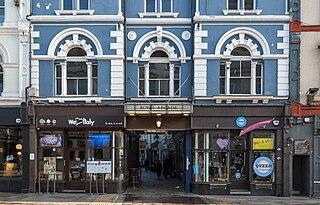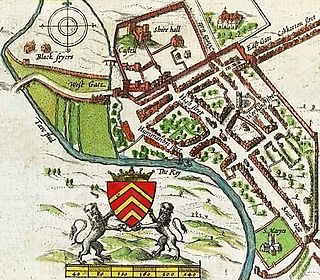
Cardiff city centre is the city centre and central business district of Cardiff, Wales. The area is tightly bound by the River Taff to the west, the Civic Centre to the north and railway lines and two railway stations – Central and Queen Street – to the south and east respectively. Cardiff became a city in 1905.

The New Theatre is one of the principal theatres of Cardiff, capital city of Wales. It is located in the city centre on Park Place, close to Cathays Park.

The Cockpit was a theatre in London, operating from 1616 to around 1665. It was the first theatre to be located near Drury Lane. After damage in 1617, it was named The Phoenix.

Lisle's Tennis Court was a building off Portugal Street in Lincoln's Inn Fields in London. Originally built as a real tennis court, it was used as a playhouse during two periods, 1661–1674 and 1695–1705. During the early period, the theatre was called Lincoln's Inn Fields Playhouse, also known as The Duke's Playhouse, The New Theatre or The Opera. The building was rebuilt in 1714, and used again as a theatre for a third period, 1714–1732. The tennis court theatre was the first public playhouse in London to feature the moveable scenery that would become a standard feature of Restoration theatres.

Hugh "Binkie" Beaumont was a British theatre manager and producer, sometimes referred to as the "éminence grise" of the West End theatre. Though he shunned the spotlight so that his name was not known widely among the general public, he was one of the most successful and influential manager-producers in the West End during the middle of the 20th century.

The Salisbury Court Theatre was a theatre in 17th-century London. It was in the neighbourhood of Salisbury Court, which was formerly the London residence of the Bishops of Salisbury. Salisbury Court was acquired by Richard Sackville in 1564 during the last seven years of his life when he was Chancellor of the Exchequer under Queen Elizabeth; when Thomas Sackville was created Earl of Dorset in 1604, the building was renamed Dorset House.

Bute Street is a street in Cardiff, Wales. It links Cardiff Bay and Butetown with Cardiff city centre. It now has no road number. It runs from the dockside of the Mermaid Quay complex in the south, which is now a pedestrian zone, to the junction of Bute Terrace (A4160) in the north.

The Cardiff Centenary Walk is a tourist walkway through Cardiff city centre in Wales. Established as part of Cardiff's centennial celebrations to mark 100 years of city status in 2005, it has 41 points of interest, either Cardiff landmarks or significant historic sites. The route is marked by waymarkers on the pavement, which also direct pedestrians to the next waymarker. The whole walk is 3.6 kilometres (2.2 mi) long running around Cardiff in a clockwise direction, starting and finishing at the Cardiff Visitor Centre at the Old Library.

The Hayes is a commercial area in the southern city centre of the Welsh capital, Cardiff. Centred on the road of that name leading south towards the east end of the city centre, the area is mostly pedestrianised and is the location of the Hayes Island Snack Bar.

St Mary Street and High Street are major commercial streets in the Castle Quarter of Cardiff city centre, Wales, which form a major thoroughfare running south from the gatehouse of Cardiff Castle. High Street begins at the junction of Castle Street on the A4161 and ends at the junction of Church Street and Quay Street, from where St Mary Street begins until the roundabout at Callaghan Square on the A4160.

Architecture in Cardiff, the capital city of Wales, dates from Norman times to the present day. Its urban fabric is largely Victorian and later, reflecting Cardiff's rise to prosperity as a major coal port in the 19th century. No single building style is associated with Cardiff, but the city centre retains several 19th and early 20th century shopping arcades.

The Royal Arcade is a shopping arcade in Cardiff, South Wales.

John Stanley Coombe Beard FRIBA, known professionally as J. Stanley Beard, was an English architect known for designing many cinemas in and around London.

St Mary's Church was an Anglican church in Cardiff, Wales, which stood at the south end of the current St. Mary's Street, from 1107 until 1620. After severe flood damage it was abandoned in 1701 and later replaced at a different location in 1843.

The Queen's Hall in Minehead, Somerset, England, was built in 1914 on the sea front of Minehead as a theatre for films and live performances.

The Angel Hotel is a hotel on a prominent corner of Castle Street and Westgate Street in the centre of Cardiff, Wales. Tracing its history back to at least the 18th century, for much of its existence it has been one of the major hotels in Cardiff, visited by celebrities and prime ministers.

The Royal Hotel is a Grade II listed hotel on a prominent corner of St Mary Street/Wood Street in the centre of Cardiff, Wales. It is Cardiff's oldest grand hotel.

The Old Library is a Grade II* listed building in Cardiff, Wales. It is located in the centre of the city at the northern end of The Hayes. Originally the Cardiff Free Library, it was used as the city's Central Library until it was replaced in 1988. It has been used for other purposes since that time and is currently the home of the Cardiff Story museum and Menter Caerdydd, a community-based Menter Iaith organisation which works to raise the profile of the Welsh language in Cardiff.
The Theatre Royal on Hindley Street, Adelaide was a significant venue in the history of the stage and cinema in South Australia. After a small predecessor of the same name on Franklin Street, the Theatre Royal on Hindley Street was built in 1868. It hosted both stage performances and movies, passing through several changes of ownership before it was eventually demolished to make way for a multi-storey car park in 1962.





















